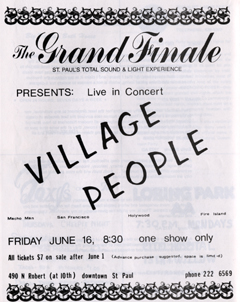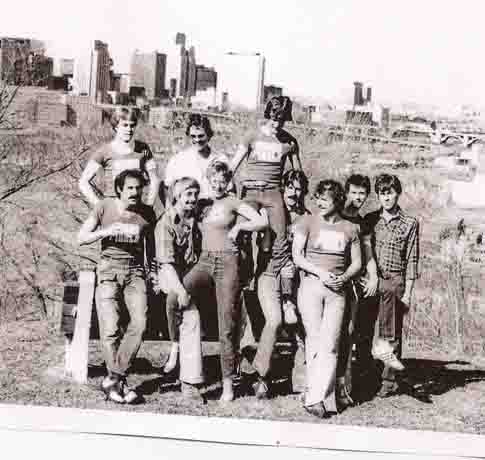Difference between revisions of "The Grand Finale"
m (Protected "The Grand Finale" [edit=sysop:move=sysop]) |
|||
| (9 intermediate revisions by one other user not shown) | |||
| Line 1: | Line 1: | ||
| − | + | <div style="text-align: center;"> | |
| + | '''490 North Robert Street, St. Paul, MN (1977-1982)''' | ||
| + | </div> | ||
| + | |||
| + | |||
| + | Chester Daxe became the second queer person to open a St. Paul queer bar in 1977.<small>(1)</small> Honey Harold holds the distinction as the first—she opened [[Foxy's Bar]] in 1968. Unlike Foxy’s, the Grand finale catered to queer men; the discotec attracted many of the men who once frequented [[The Noble Roman]] on [[Grand Avenue]]. | ||
| + | |||
| + | |||
| + | The Finale is especially notable in the queer history of St. Paul because it attracted infamous music artists to downtown St. Paul’s nightclubs—historically, the capital city’s nightlife has lacked the same vitality of its “twin” to the west. | ||
| + | |||
| + | |||
| + | |||
| + | {| {{prettytable}} | ||
| + | ! | ||
| + | ! | ||
| + | |- | ||
| + | | <div style="text-align: center;"> | ||
| + | [[Image:Svc_grndfinale.jpg]] | ||
| + | </div> <div style="text-align: center;"> | ||
| + | <small>'''Advertisement for the Village People's performance in the Finale, from the 1978 Twin Cities Pride guide. Courtesy of the [[Jean-Nickolaus Tretter Collection]].'''</small> | ||
| + | </div> | ||
| + | | Perhaps most notably, the Finale hosted The Village People<small>(2)</small>—from Greenwich Village in New York, the musical group featured icons of the gay world: a cowboy, a leatherman (often mistaken for a “biker”), an officer, a construction worker, a soldier, and an “Indian.” Donning moustaches and machismo, the group campily popularized popular themes for queer men. | ||
| + | |||
| + | |||
| + | This is even evident in the titles of the group’s hit songs: gay men found others “In the Navy,” you could hang out with all the boys at the “Y.M.C.A.,” and by all means you wanted to find a “Macho Man.”<small>(3)</small> | ||
| + | |||
| + | |||
| + | The Village People were not the only notable musicians to perform at the Finale. Grace Jones—a Jamaican-American artist who bended gender norms at will—visited the venue in the early years of her career. Other notable performers were Linda Clifford (who sang “Runaway Love”—a minor disco hit), Karen Young (of “Hot Shot” fame), and Vickie Sue Robinson (who sang the original “Turn the Beat Around”). <small>(4)</small> | ||
| + | |} | ||
| + | |||
| + | |||
| + | The Finale closed in 1982, along The Barefoot Boy Health Club next door.<small>(5)</small> The Finale was first in a long line of queer bars to use the old Shultze Shoe Factory—[[Rumours and Innuendo]], Club Vogue, Rocky’s on 10th, Trixx, and a second iteration of [[Foxy's Bar]] followed the Finale. Presently, [[Camp Bar]] continues the longstanding tradition. | ||
| + | |||
| + | <div style="text-align: center;"> | ||
| + | [[Image:Grand Finale staff picnic 1979.jpg]] | ||
| + | </div> | ||
| + | <div style="text-align: center;"> | ||
| + | <small>'''Photo of the Grand Finale staff picnic on [[The West Side Flats]] in 1979. Image courtesy of Chester Daxe, the Finale's onetime owner.'''</small> | ||
| + | </div> | ||
---- | ---- | ||
| − | + | ||
| + | |||
| + | <small>(1)</small>Announcement of the Grand finale opening in July of 1977. Twin Cuities Pride Guide, 1977. Back Cover. | ||
| + | |||
| + | <small>(2)</small> Village People Advertisement. 1978 Twin Cities Pride Guide, page 10. | ||
| + | |||
| + | <small>(3)</small> Gage, Simon; Richards, Lisa; Wilmot, Howard, and Boy George. "The Village People: How a Biker, A Policeman, A Construction Worker, A Cowboy, A Soldier, and a Red indian became the first crossover 'Gay' Stars." From ''Queer.'' New York: Thunder's Mouth Press, 2002. Page 140. | ||
| + | |||
| + | <small>(4)</small> See below comment. | ||
| + | |||
| + | <small>(5)</small> Daxe, Chester. Correspondence with the author, 3/21/10 | ||
Part of [[Minneapolis/St. Paul, MN: 100 Queer Places in Minnesota History, (1860-1969), (1969-2010)]] | Part of [[Minneapolis/St. Paul, MN: 100 Queer Places in Minnesota History, (1860-1969), (1969-2010)]] | ||
Latest revision as of 11:25, 1 May 2010
490 North Robert Street, St. Paul, MN (1977-1982)
Chester Daxe became the second queer person to open a St. Paul queer bar in 1977.(1) Honey Harold holds the distinction as the first—she opened Foxy's Bar in 1968. Unlike Foxy’s, the Grand finale catered to queer men; the discotec attracted many of the men who once frequented The Noble Roman on Grand Avenue.
The Finale is especially notable in the queer history of St. Paul because it attracted infamous music artists to downtown St. Paul’s nightclubs—historically, the capital city’s nightlife has lacked the same vitality of its “twin” to the west.
| Advertisement for the Village People's performance in the Finale, from the 1978 Twin Cities Pride guide. Courtesy of the Jean-Nickolaus Tretter Collection. |
Perhaps most notably, the Finale hosted The Village People(2)—from Greenwich Village in New York, the musical group featured icons of the gay world: a cowboy, a leatherman (often mistaken for a “biker”), an officer, a construction worker, a soldier, and an “Indian.” Donning moustaches and machismo, the group campily popularized popular themes for queer men.
|
The Finale closed in 1982, along The Barefoot Boy Health Club next door.(5) The Finale was first in a long line of queer bars to use the old Shultze Shoe Factory—Rumours and Innuendo, Club Vogue, Rocky’s on 10th, Trixx, and a second iteration of Foxy's Bar followed the Finale. Presently, Camp Bar continues the longstanding tradition.
Photo of the Grand Finale staff picnic on The West Side Flats in 1979. Image courtesy of Chester Daxe, the Finale's onetime owner.
(1)Announcement of the Grand finale opening in July of 1977. Twin Cuities Pride Guide, 1977. Back Cover.
(2) Village People Advertisement. 1978 Twin Cities Pride Guide, page 10.
(3) Gage, Simon; Richards, Lisa; Wilmot, Howard, and Boy George. "The Village People: How a Biker, A Policeman, A Construction Worker, A Cowboy, A Soldier, and a Red indian became the first crossover 'Gay' Stars." From Queer. New York: Thunder's Mouth Press, 2002. Page 140.
(4) See below comment.
(5) Daxe, Chester. Correspondence with the author, 3/21/10
Part of Minneapolis/St. Paul, MN: 100 Queer Places in Minnesota History, (1860-1969), (1969-2010)

